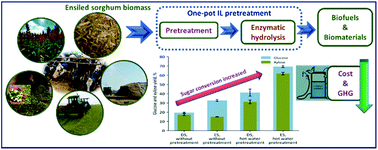Use of ensiled biomass sorghum increases ionic liquid pretreatment efficiency and reduces biofuel production cost and carbon footprint†
Abstract
Pretreatment is an essential step to enable the efficient conversion of lignocellulosic biomass to biofuels and bioproducts. The most effective pretreatment methods currently in use are based on severe thermochemical approaches, which are costly and energy-intensive. Here we explored whether the common practice of ensiling grassy biomass, such as sorghum, could be used as a pre-processing step to increase the conversion efficiency under milder pretreatment conditions. We determined the impact of replacing dry sorghum biomass with ensiled sorghum biomass on the deconstruction efficiency, process economics, and carbon footprint of a lignocellulosic biorefinery that employs a separation-free ionic liquid pretreatment coupled to enzymatic saccharification and microbial conversion. Our results indicate that the use of ensiled biomass allowed for a 50% reduction in both the amount of ionic liquid (from 5 to 2.5% (w/w) as measured by initial pretreatment loading) and the time required for enzymatic saccharification (from 72 h to 24 h) without sacrificing efficiency. We show that the resulting hydrolysate can be used to cultivate an engineered strain of Rhodosporidium toruloides to convert >90% of the monomeric sugars into bisabolene, a promising intermediate to biofuels and bioproducts. Overall, we estimate that the replacement of field-dried biomass sorghum with ensiled sorghum in combination with an ionic liquid-based deconstruction process could reduce the minimum selling price and carbon footprint of biofuel production in a biorefinery by at least 13% and 8.2%, respectively.



 Please wait while we load your content...
Please wait while we load your content...